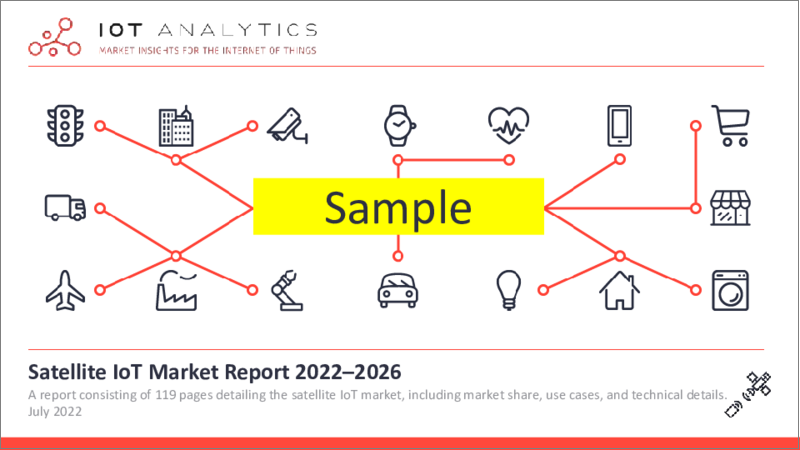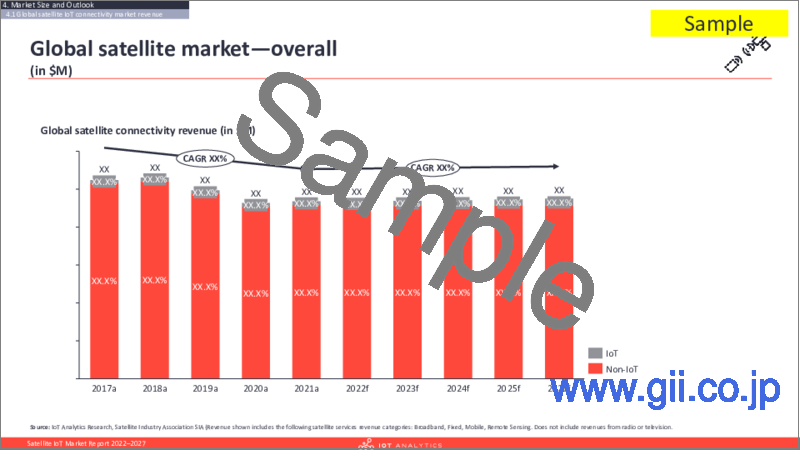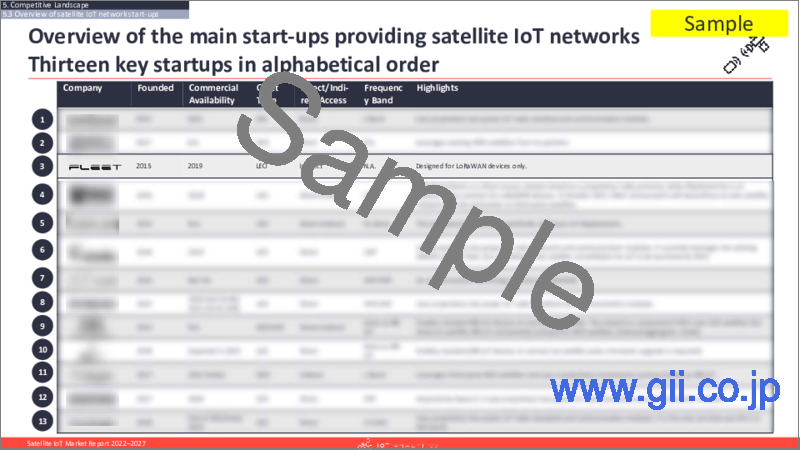|
|
市場調査レポート
商品コード
1108017
衛星IoTの世界市場の分析 (2022年~2026年)Satellite IoT Market Report 2022-2026 |
||||||
| 衛星IoTの世界市場の分析 (2022年~2026年) |
|
出版日: 2022年07月31日
発行: IoT Analytics GmbH
ページ情報: 英文 119 Pages
納期: 即日から翌営業日
|
- 全表示
- 概要
- 目次
当レポートでは、世界の衛星IoTコネクティビティ市場について詳細に分析しております。
- 衛星IoTコネクティビティ技術の概要と、その基盤となる基本的な技術概念
- 市場規模 (収益、契約件数) の実績値 (2017年~2021年) と予測値 (2022年~2026年)、地域別・セグメント別・技術カテゴリ別の詳細動向
- ベンダー情勢の分析:企業プロファイル、市場シェア分析、主要技術の相違点など
- 市場の主な動向:7種類の主要トレンド、4種類の主要課題、関連する事例や実証例など
- プロジェクトのケーススタディ (全9件):各プロジェクトの課題、技術的解決策、結果など
当レポートは、IoT Analyticsが継続的に行っているIoT接続とハードウェア市場(IoT Connectivity & Hardware)の報道の一部です。本レポートに掲載されている情報は、2021年9月から2022年5月にかけて実施した、20件以上の業界関係者とのインタビューやディスカッション、さらに各種オンラインブリーフィングやプレゼンテーションへの出席、個別の二次調査に基づいています。本書の主な目的は、市場の定義、規模、分析を行うことで、読者が現在の衛星IoT接続の情勢を理解できるようにすることです。
当レポートの分析内容:
- 衛星IoTコネクティビティとは何か?
- 衛星IoTコネクティビティの製品・サービスが構築される基礎的な技術的側面と技術とは何か?
- 衛星IoTコネクティビティの市場規模・成長率はどれだけか? (地域別、業種別、技術カテゴリ別)
- 現在のベンダーの情勢はどの程度の規模か?主要ベンダーとその市場シェアは?どのようなスタートアップが台頭し、どのようなイノベーションを市場に提供しているのか?
- 衛星IoTコネクティビティの主な利点・欠点は何か?
- 衛星IoTコネクティビティ市場の主要な動向と課題は何か?
- 衛星IoTコネクティビティの導入に成功した実際の事例には、どのようなものがあるか?
概要
衛星IoTとは、衛星通信ネットワークとサービスを利用して、地上のIoTセンサーとIoTエンドノードを、地上の通信ネットワークと連携して、またはその代替として、サーバー(パブリックまたはプライベート・クラウドなど)に接続することを指します。
衛星IoT接続は、2つの異なる種類のネットワークで実行できます。
- 低電力衛星ネットワークは、バッテリー駆動の小型デバイスからのナローバンド、ショートバースト(数KBまで)のデータ伝送に最適化されており、リモートセンサー監視や資産追跡などの様々な低スループットのIoTアプリケーションに対応します。
- 従来の衛星ネットワークは、低スループットの非IP IoT/M2Mアプリケーションにも対応していますが、ほとんどがIPベースの広帯域データおよび音声通信用に設計されています。これらのネットワークは、遠隔地やモバイル資産(消費者や航空、海運、石油・ガスなどの産業)へのインターネット接続サービスの提供、ファーストレスポンダーや緊急通信、センサー密度の高いローカルIoTネットワークのバックホールなどに最適です。
IoTデバイスに衛星接続を提供するには、4つの方法があります。
ダイレクトアクセス接続(Direct-to-satelliteまたはDirect-to-orbit)により、IoTデバイスは、中間的な地上ゲートウェイを必要とせず、衛星ネットワークと直接通信することができるようになります。
衛星IoT接続市場は、2026年までに960Mドル超に成長すると予測されています。
IoT Analyticsは、衛星IoT接続サービスを提供する40社以上を特定しました。
競合情勢の章では、ベンダーマップのほか、ベンダー別の市場シェア、ベンダー分析、10社のプロファイルを掲載しています。
市場レポートには、様々な業界における9つの衛星IoTのケーススタディが含まれています。
当レポートの主な分析対象企業
|
|
目次
第1章 エグゼクティブサマリー
第2章 トピックの概要
- IoT AnalyticsによるIoTの定義
- 衛星IoTの定義
- 衛星IoTと他のIoTワイヤレステクノロジの比較
- IoT向け衛星通信の現状
- 衛星IoTの主な利点
- 衛星IoTの主な欠点
- 衛星IoTを検討する時期
- 主なセグメントとユースケースの概要
第3章 技術概要
- このレポートで説明する主要な技術的概念
- 衛星IoTのネットワークアーキテクチャ
- デバイス接続の構成
- 衛星商用サービスのカテゴリ
- 衛星の周波数帯域
- 小型衛星とキューブサット
- 衛星コンステレーション
- 衛星軌道
- LPGAN (低電力世界エリアネットワーク)
第4章 市場規模と展望
- 世界の衛星IoTコネクティビティ市場の収益
- 世界の衛星コネクティビティ市場の収益
- 世界の衛星IoTコネクティビティ市場の収益
- 世界の衛星IoTコネクティビティ市場の収益:地域別
- 世界の衛星IoTコネクティビティ市場の収益:業種別
- 世界な衛星IoTコネクティビティの加入者数
- 世界の衛星IoTコネクティビティ加入者数:周波数帯域別
- 世界の衛星IoTコネクティビティ加入者数:通信モード別
- IoT加入者数:衛星軌道別
- 世界の衛星IoTコネクティビティのARPU:上位5社
第5章 競合情勢
- 衛星IoTコネクティビティ:ベンダーマップ
- 既存の衛星IoTネットワーク事業者の概要
- 衛星IoTネットワーク:スタートアップの概要
- 衛星IoTコネクティビティの市場シェア:ベンダー別
- ベンダー分析:衛星軌道
- ベンダー分析:IoTコネクティビティの構成
- ベンダー分析:ダイレクトモード接続
- ベンダー分析:周波数帯域
- ベンダー分析:地理的分布
- 企業プロファイル
第6章 動向と課題
第7章 ケーススタディ
第8章 調査手法と市場の定義
第9章 IoT Analyticsについて
A 119-page market report detailing the Satellite IoT connectivity market:
- Detailed overview of Satellite IoT connectivity technologies and the fundamental technical concepts on which they're built
- Market size including actuals for the 2017 - 2021 period and outlook for the 2022-2026 period, including 9 market charts detailing the global market revenue and number of IoT subscriptions by region, segment, and different technology categories
- Vendor landscape analysis including 10 company profiles, 8 market share analysis charts and 6 charts analysing the technological differences in the offering of the surveyed companies
- Main developments in the market highlighting 7 key trends and 4 key challenges, which are discussed in detail with relevant examples and proof-points
- Case study analysis of 9 projects, including the issue, the technical solution and the results of each project
The “Satellite IoT Market Report 2022-2026” is part of IoT Analytics' ongoing coverage of the IoT connectivity and hardware market (IoT Connectivity & Hardware). The information presented in this report is based on 20+ interviews and discussions with industry representatives, in addition to attendance of various on-line briefings and presentations as well as individual secondary research conducted between September 2021 and May 2022. The main purpose of this document is to help our readers understand the current Satellite IoT connectivity landscape by defining, sizing, and analyzing the market.
Find out:
- What is satellite IoT connectivity?
- What are the fundamental technical aspects and technologies upon which satellite IoT connectivity products and services are built on?
- How big is the Satellite IoT Connectivity market and how fast is it growing (by region, industry, and technology categories)?
- How big is the current vendor landscape? Who are the main vendors and what are their market shares? Which start-ups are emerging, and what innovations are they bringing to the market?
- What are the key benefits and main drawbacks of satellite IoT connectivity?
- What are the key trends and challenges in the satellite IoT connectivity market?
- What are some examples of successful implementation of satellite IoT connectivity in real-life case studies?
At a glance:
Satellite IoT refers to the use of satellite communication networks and services to connect terrestrial IoT sensors and IoT end-nodes to a server (e.g. in a public or private cloud), either in conjunction with or as an alternative to terrestrial communication networks.
Satellite IoT connections can run on two different kinds of networks:
- 1. Low-power satellite networks are optimized for narrowband, short-burst data transmissions (up to a few kB) from small, battery-operated devices, and address various low-throughput IoT applications such as remote sensor monitoring and asset tracking.
- 2. Traditional satellite networks are mostly designed for broadband IP-based data and voice communication, although they also support lower throughput non-IP IoT/M2M applications. These networks are best suited to providing internet connectivity services to remote areas or mobile assets (e.g. to consumers or industries such as aviation, maritime, and oil & gas), for first responder and emergency communications, and backhauling of local IoT networks with high sensor density.
There are four ways to provide satellite connectivity to IoT devices.
Direct Access connectivity (direct-to-satellite or direct-to-orbit) allows IoT devices to directly communicate with a satellite network, without the need for an intermediate terrestrial gateway.
The satellite IoT connectivity market is projected to grow to over $960M by 2026.
IoT Analytics has identified over 40 companies providing satellite IoT connectivity services.
Besides a vendor map, the competitive landscape chapter includes market shares by vendor, vendor analyses, and 10 company profiles.
The market report includes 9 satellite IoT case studies across various industries.
Selected companies mentioned in the report:
|
|
Table of Contents
1. Executive Summary
2. Topics at a glance
- 2.1. IoT Analytics' definition of IoT
- 2.2. Definition of satellite IoT
- 2.3. Satellite IoT vs. other IoT wireless technologies
- 2.4. The current state of satellite communications for IoT
- 2.5. The main benefits of satellite IoT
- 2.6. The main drawbacks of satellite IoT
- 2.7. When to consider satellite IoT
- 2.8. Overview of key segments and use cases
3. Technology Overview
- 3.1. Key technical concepts discussed in this report
- 3.2. Satellite IoT network architecture
- 3.3. Device connectivity configurations
- 3.4. Satellite commercial services categories
- 3.5. Satellite frequency bands
- 3.6. Smallsats and CubeSats
- 3.7. Satellite constellations
- 3.8. Satellite orbits
- 3.9. Low-Power Global Area Networks (LPGAN)
4. Market Size and Outlook
- 4.1. Global satellite IoT connectivity market revenue
- 4.1.1. Global satellite connectivity market revenue
- 4.1.2. Global satellite IoT connectivity market revenue
- 4.1.3. Global satellite IoT connectivity market revenue by region
- 4.1.4. Global satellite IoT connectivity market revenue by industry
- 4.2. Global satellite IoT connectivity subscribers
- 4.2.1. Global satellite IoT connectivity subscribers by frequency band
- 4.2.2. Global satellite IoT connectivity subscribers by communication mode
- 4.2.3. Number of IoT subscribers by satellite orbit
- 4.3. Global satellite IoT connectivity ARPU-top five companies
5. Competitive Landscape
- 5.1. Satellite IoT connectivity vendor map
- 5.2. Overview of established satellite IoT network operators
- 5.3. Overview of satellite IoT network start-ups
- 5.4. Satellite IoT connectivity market share by vendor
- 5.5. Vendor analysis: Satellite orbits
- 5.6. Vendor analysis: IoT connectivity configurations
- 5.7. Vendor analysis: Direct mode connectivity
- 5.8. Vendor analysis: Frequency bands
- 5.9. Vendor analysis: Geographical distribution
- 5.10. Company profiles
6. Trends and Challenges
- 6.1. Key trends
- 6.2. Key challenges




